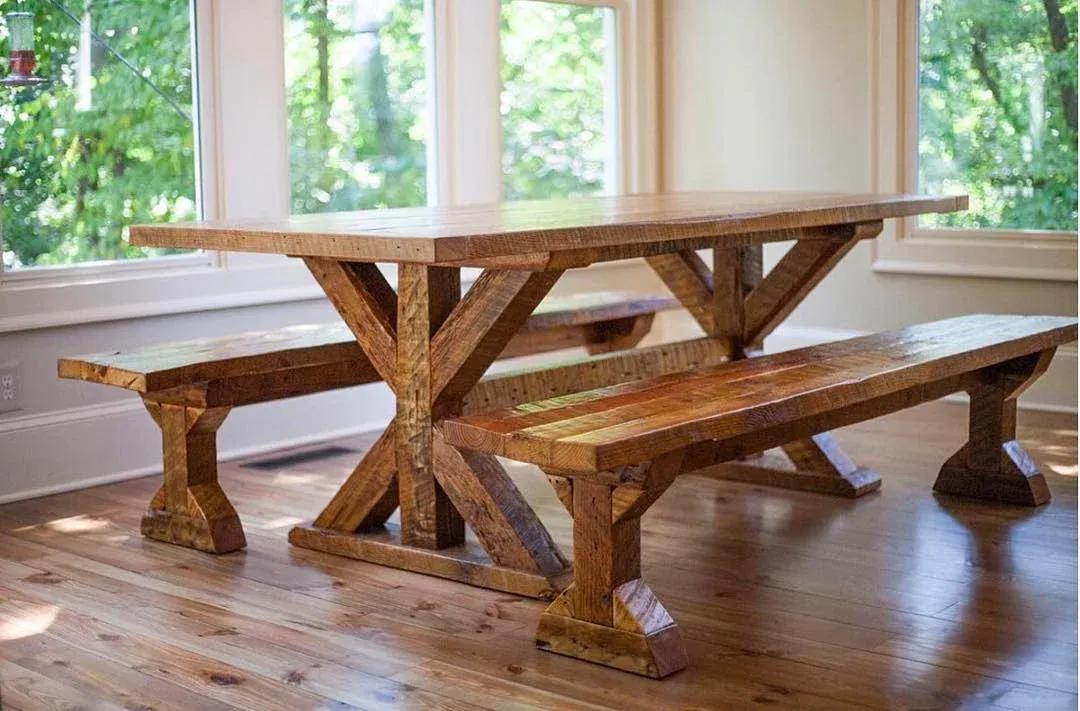What is a Trestle Table?
Trestle tables bridge centuries of dining history, their sturdy legs and long spans hosting everything from medieval feasts to modern family dinners.

Sons of Sawdust Trestle Table
From medieval feast halls to modern farmhouse kitchens, the trestle table has stood the test of time—quite literally. This stalwart of the furniture world has supported everything from kings' banquets to family dinners, all while maintaining an air of rustic elegance. But what exactly gives the trestle table its enduring appeal? Let's unfold the story of this versatile piece of furniture.
The Essence of a Trestle Table
At its core, a trestle table consists of a long tabletop supported by trestle legs rather than four corner legs. Think of it as the architectural bridge of the furniture world—a span supported at intervals rather than continuously along its length. This design not only provides stability but also offers a unique aesthetic and practical benefits that have kept it in vogue for centuries.
A Journey Through Time: The History of Trestle Tables
The trestle table's story begins in the Middle Ages, where its portable nature made it a favorite in Great Halls of castles and manors. These early tables could be quickly assembled for meals and then disassembled to clear space for other activities—medieval multifunctioning at its finest.
As time progressed, trestle tables evolved from purely functional pieces to objects of craftsmanship. The Renaissance saw ornately carved trestles supporting richly inlaid tabletops. Fast forward to the Arts and Crafts movement of the late 19th century, and trestle tables experienced a revival, celebrated for their honest construction and connection to traditional craftsmanship.
Today, trestle tables continue to be popular, fitting seamlessly into a variety of decor styles from rustic farmhouse to industrial chic to modern minimalist.
Anatomy of a Trestle Table
Understanding the components of a trestle table helps appreciate its design:
- Tabletop: Usually a long, rectangular surface, though round versions exist.
- Trestles: The supportive structures at each end, often A-frame or H-frame in shape.
- Stretcher: A long beam connecting the trestles, providing stability.
- Feet: The bottom of the trestles, often wider for added stability.
Types of Trestle Tables
Trestle tables come in various styles to suit different tastes and needs:
- Traditional Farmhouse: Rustic wood with simple, sturdy trestles.
- Industrial: Often combining wood tops with metal trestles.
- Modern Minimalist: Sleek lines and simple forms, often in lighter wood or painted finishes.
- Ornate Antique: Featuring detailed carvings and inlays, hearkening back to Renaissance styles.
- Convertible: Modern adaptations that can change in size or height.
The Versatility of Trestle Tables
One of the trestle table's greatest strengths is its adaptability to various settings:
- Dining Room: Its traditional home, providing ample space for family meals and entertaining.
- Kitchen: As a generous island or eat-in kitchen table.
- Home Office: A spacious desk with room for multiple workstations.
- Craft Room: The long surface is perfect for spreading out projects.
- Outdoor Spaces: Many trestle tables are sturdy enough for patio or garden use.
Choosing the Right Trestle Table
When selecting a trestle table, consider these factors:
- Size: Measure your space carefully. Trestle tables can be quite long, but their design often allows for more seating than traditional tables.
- Material: Wood is traditional, but metal, glass, and combinations are available.
- Style: Choose a design that complements your existing decor.
- Stability: Ensure the trestles and stretcher are sturdy enough for your needs.
- Clearance: Check that the trestle placement allows for comfortable seating.
Styling Your Trestle Table
The beauty of a trestle table lies in its versatility. Here are some styling tips:
- For a farmhouse look, pair with Parsons chairs or benches.
- In a modern setting, contrast the rustic table with sleek, contemporary chairs.
- Use a runner to add color and protect the tabletop.
- For everyday elegance, try a simple centerpiece of seasonal flowers or fruits.
- In a home office, use decorative organizers to keep the long surface tidy.
Trestle Tables vs. Other Table Styles
While trestle tables have unique advantages, it's worth comparing them to other styles:
- Four-Leg Tables: Generally offer more legroom but less flexibility in seating arrangements.
- Pedestal Tables: Provide more legroom but may be less stable for very long tables.
- Expandable Tables: Offer size flexibility, which some trestle tables lack.
Caring for Your Trestle Table
To keep your trestle table in top condition:
- Use coasters and placemats to protect the surface from moisture and heat.
- Clean with a soft, damp cloth and avoid harsh chemicals.
- For wooden tables, polish or oil periodically to maintain the finish.
- Check and tighten any bolts or screws regularly, especially on the trestles and stretcher.
- Use furniture pads under the feet to protect your floors.
Final Thoughts
The trestle table is more than just a place to eat or work—it's a piece of history that continues to evolve with our changing needs and styles. Its enduring popularity is a testament to the brilliance of its design: a perfect balance of form and function, strength and elegance, tradition and adaptability.
Whether you're hosting a grand feast, spreading out your latest craft project, or simply gathering the family for a weeknight dinner, a trestle table provides a sturdy, stylish foundation for life's activities. It's a reminder that some designs are truly timeless, adapting to our needs while maintaining their core identity.
So, if you're looking for a table that combines historical charm with practical functionality, consider the trestle table. It's been the strong, silent type holding up our plates, projects, and elbows for centuries—and it's ready to support whatever you bring to the table.
Check out trestle tables and other dining table styles on Spoken and never overpay making your home beautiful!
Quick facts
What is the advantage of a trestle table?
Trestle tables offer several advantages: they provide ample leg room due to their open design, are typically sturdy and stable, and can accommodate more people than traditional tables. Their simple construction makes them easy to disassemble for storage or moving. Trestle tables are also versatile, working well in various settings from rustic to modern.
Can I use a trestle table as a dining table?
Yes, trestle tables are excellent choices for dining tables. Their open base design provides plenty of legroom, making them comfortable for diners. Trestle tables come in various sizes and styles, suitable for both formal and casual dining spaces. They're particularly popular for farmhouse or rustic-style dining rooms but can fit many decor themes.
What is the purpose of a trestle?
A trestle serves as a support structure, originally designed to create a sturdy, portable base for tables. In furniture, trestles form the legs of a table, typically consisting of two or more vertical supports connected by a horizontal beam. This design provides stability while allowing for easy disassembly, making trestle tables both functional and versatile.
What is a trestle table called?
A trestle table is simply called a "trestle table." This name directly describes its construction, featuring trestle supports instead of four individual legs. Sometimes they're referred to as "farmhouse tables" or "refectory tables" when used in specific design contexts, but "trestle table" remains the most common and accurate term for this style of table.

Anirudh Atodaria
Software Engineer at Spoken
Anirudh is a software engineer at Spoken. He enjoys learning new things and solving complex problems. He takes pride in making others lives easier through innovative technology solutions. While he spends most of his time immersed in coding and tech, he tries to touch some grass occasionally.
Read more